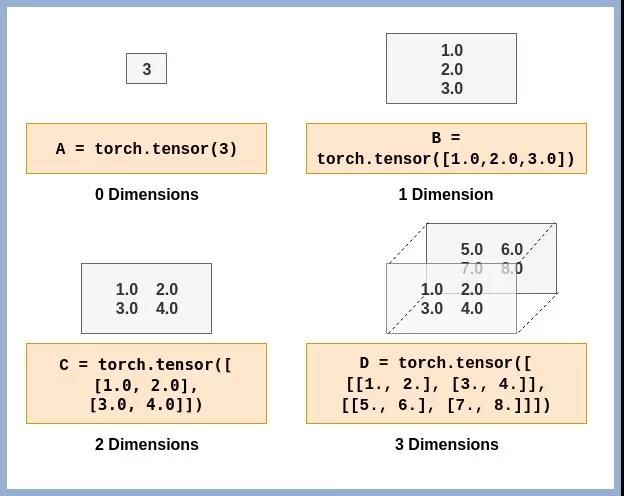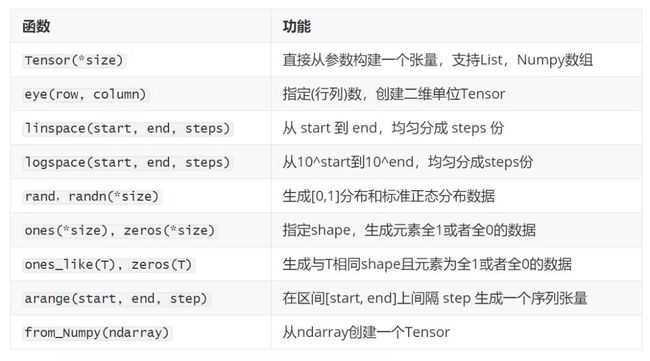详解Tensor用法
Tensor的操作
如果本文对你有帮助,欢迎点赞、订阅以及star我的项目。
你的支持是我创作的最大动力!
张量的数据属性与 NumPy 数组类似,如下所示:
张量的操作主要包括张量的结构操作和张量的数学运算操作。
- Tensor的结构操作包括:创建张量,查看属性,修改形状,指定设备,数据转换, 索引切片,广播机制,元素操作,归并操作;
- Tensor的数学运算包括:标量运算,向量运算,矩阵操作,比较操作。
创建张量
Pytorch中创建张量的方法有很多,如下图所示:
在深度学习过程中最多使用 5 5 5个维度的张量:标量(0维张量),向量(1维度张量),矩阵(2维张量),3维张量,4维张量,5维张量。
创建标量**(0维张量)**
仔细观察下述代码,看看有什么区别:
x = torch.tensor(2)
print(x, x.shape, x.type())
y = torch.Tensor(2)
print(y, y.shape, y.type())
tensor(2) torch.Size([])
torch.LongTensortensor([0., 0.]) torch.Size([2])
torch.FloatTensor
注意到了torch.tensor与torch.Tensor的区别没?一字之差,结果差别却很大。
- torch.Tensor(2) 使用全局默认 dtype(FloatTensor),返回一个size为 2 2 2的向量,初值为 0 0 0;
- torch.tensor(2) 返回常量 2 2 2,数据类型从数据推断而来,其中的 2 2 2表示的是数据值。
创建向量(1维度张量)
向量只不过是一个元素序列的数组。例如,表示一个地区一段时间的气温。
x = torch.FloatTensor([23.5, 24.6, 25.9, 26.1])
print(x, x.shape, x.type())
tensor([23.5000, 24.6000, 25.9000, 26.1000]) torch.Size([4])
torch.FloatTensor
创建矩阵(2维向量)
从上面可知,创建矩阵的方式有很多,我们选择 from_numpy 的方式将 numpy 数组转换成 torch 张量。下面以波士顿房价的数据集为例子,它包含在机器学习包scikit-learn中。该数据集包含了 506 个样本,其中每个样本有 13 个特征。
from sklearn.datasets import load_bostonboston = load_boston() # 下载数据集
boston_tensor=torch.from_numpy(boston.data)
print(boston_tensor[:2])
print(boston_tensor.shape)
print(boston_tensor.type())
tensor([[6.3200e-03, 1.8000e+01, 2.3100e+00, 0.0000e+00, 5.3800e-01, 6.5750e+00, 6.5200e+01, 4.0900e+00, 1.0000e+00, 2.9600e+02, 1.5300e+01, 3.9690e+02, 4.9800e+00], [2.7310e-02, 0.0000e+00, 7.0700e+00, 0.0000e+00, 4.6900e-01, 6.4210e+00, 7.8900e+01, 4.9671e+00, 2.0000e+00, 2.4200e+02, 1.7800e+01, 3.9690e+02, 9.1400e+00]], dtype=torch.float64)
torch.Size([506, 13])
torch.DoubleTensor
最常见的三维张量就是图片,例如 [ 224 , 224 , 3 ] [224, 224, 3] [224,224,3],下面我们演示如何加载图片数据。
from PIL import Image
panda = np.array(Image.open("../images/panda.jpg").resize((224,224)))
panda_tensor=torch.from_numpy(panda)
print(panda_tensor.size())
print(panda_tensor.dtype)
plt.imshow(panda_tensor)
torch.Size([224, 224, 3])torch.uint8
创建4维张量
4维张量最常见的例子就是批图像。例如,加载一批 [ 64 , 224 , 224 , 3 ] [64, 224, 224, 3] [64,224,224,3] 的图片,其中 64 64 64 表示批尺寸, [ 224 , 224 , 3 ] [224, 224, 3] [224,224,3] 表示图片的尺寸。
from glob import glob
data_path = "./data/cats/"
imgs = glob(data_path+'*.jpg')
imgs_np = np.array([np.array(Image.open(img).resize((224,224))) for img in imgs])
imgs_np = imgs_np.reshape(-1, 224, 224, 3)
imgs_tensor=torch.from_numpy(imgs_np)
print(imgs_tensor.shape)
print(imgs_tensor.dtype)
torch.Size([397, 224, 224, 3])
torch.uint8
上面代码中一共读取了 397 397 397 张图片。
创建5维张量
使用5维度张量的例子是视频数据。视频数据可以划分为片段,一个片段又包含很多张图片。例如, [ 32 , 30 , 224 , 224 , 3 ] [32, 30, 224, 224, 3] [32,30,224,224,3] 表示有 32 32 32 个视频片段,每个视频片段包含 30 30 30 张图片,每张图片的尺寸为 [ 224 , 224 , 3 ] [224, 224, 3] [224,224,3]。下面,我们模拟产生这样一个尺寸的5维数据(注意:只是模拟产生 5 5 5维数据,并不是真的视频数据)。
video_tensor=torch.randn(32,30,224,224,3)
print(video_tensor.shape)
print(video_tensor.dtype)
torch.Size([32, 30, 224, 224, 3])
torch.float32
查看属性
张量有很多属性,下面我们看看常用的属性有哪些?
- tensor.shape,tensor.size(): 返回张量的形状;
- tensor.ndim:查看张量的维度;
- tensor.dtype,tensor.type():查看张量的数据类型;
- tensor.is_cuda:查看张量是否在GPU上;
- tensor.grad:查看张量的梯度;
- tensor.requires_grad:查看张量是否可微。
tensor = torch.randn(2,3)
print("形状: ", tensor.shape, tensor.size())
print("维度: ", tensor.ndim)
print("类型: ", tensor.dtype, tensor.type())
print("cuda: ", tensor.is_cuda)
print("梯度: ", tensor.grad)
形状: torch.Size([2, 3]) torch.Size([2, 3])
维度: 2
类型: torch.float32 torch.FloatTensor
cuda: False
梯度: None
其中,torch.FloatTensor 就是 32 32 32位的浮点数。
修改张量的形状
在处理数据和构建网络的时候,时常需要修改 Tensor 的形状。涉及到修改形状的常见函数如下:
- tensor.numel():计算Tensor的元素个数;
- tensor.view(*shape):修改Tensor的形状。view()返回的Tensor与源Tensor共享内容。使用view必须要求源Tensor是连续的,否则会执行失败。view(-1)实现展平;
- tensor.resize(*shape):功能类似与 view,resize不要求Tensor内存连续;
- tensor.reshape(*shape):修改Tensor的形状,Reshape返回新的Tensor;
- tensor.unsqueeze(pos):在指定位置添加一个维度;
- tensor.squeeze():消除维度为 1 1 1的维。
import torch
x = torch.randn(2,3)
print("元素个数: {}".format(x.numel()))
# view调整尺寸
print("\ntensor.view(3,2): \n{}".format(x.view(3,2)))
print("tensor.view(-1): {}".format(x.view(-1)))
# resize调整尺寸
print("\ntensor.resize(3,2): \n{}".format(x.resize(3,2)))
# reshape调整尺寸
print("\ntensor.reshape(3,2): \n{}".format(x.reshape(3,2)))
print("tensor.reshape(-1): {}".format(x.reshape(-1)))
#添加一个维度
x123 = x.unsqueeze(0)
x213 = x.unsqueeze(1)
x231 = x.unsqueeze(2)
print("\ntensor.unsqueeze(0): {}".format(x123.shape))
print("tensor.unsqueeze(1): {}".format(x213.shape))
print("tensor.unsqueeze(2): {}".format(x231.shape))
# 去掉维度为1的维
print("\ntensor.squeeze(): {}".format(x123.squeeze().shape))
print("tensor.squeeze(): {}".format(x213.squeeze().shape))
print("tensor.squeeze(): {}".format(x231.squeeze().shape))
元素个数: 6
tensor.view(3,2):
tensor([[ 0.1274, -1.5990], [-0.8852, -1.3436], [-0.7716, 1.5765]])
tensor.view(-1): tensor([ 0.1274, -1.5990, -0.8852, -1.3436, -0.7716, 1.5765])
tensor.resize(3,2):
tensor([[ 0.1274, -1.5990], [-0.8852, -1.3436], [-0.7716, 1.5765]])
tensor.reshape(3,2):
tensor([[ 0.1274, -1.5990], [-0.8852, -1.3436], [-0.7716, 1.5765]])
tensor.reshape(-1):
tensor([ 0.1274, -1.5990, -0.8852, -1.3436, -0.7716, 1.5765])
tensor.unsqueeze(0): torch.Size([1, 2, 3])
tensor.unsqueeze(1): torch.Size([2, 1, 3])
tensor.unsqueeze(2): torch.Size([2, 3, 1])
tensor.squeeze(): torch.Size([2, 3])
tensor.squeeze(): torch.Size([2, 3])
tensor.squeeze(): torch.Size([2, 3])
在上述函数中,有三个函数都可以调整Tensor的尺寸:view,reshape,resize。他们之间有什么区别嘛?
- reshape可以由torch.reshape(),tensor.reshape()调用,而view只能通过tensor.view()调用。
- view()方法只能改变连续的张量,否则必须先调用.contiguous()方法使内存连续;.reshape()方法不受此限制。方法.transpose(), .permute()会使的Tensor在内存中不连续。
- view() 返回的Tensor与源Tensor共享内存;.reshape()返回的Tensor与源Tensor不共享内存;
- resize() 与 .reshape()效果类似。
- 如果只想重塑Tensor,建议使用.reshape;如果关注内存希望两个Tensor共享内存,建议使用.view()。
指定设备
PyTorch 为CPU 和 GPU 提供了不同的张量实现。每个张量都可以转化到 GPU 中,以便大规模计算。创建Tensor时,默认指定的设备是CPU。
创建Tensor时,我们可以通过torch.tensor([…],dtype=,device=‘cpu/cuda’) 指定Tensor所属的设置是CPU还是GPU;也可以通过 tensor.to(device=cpu/cuda)或者tensor.cuda(),tensor.cpu() 把张量转化到指定的设备上。
# 创建CPU上的张量
tensor_cpu = torch.tensor([[1.0, 2.0], [3.0, 4.0], [5.0, 6.0]], dtype=torch.float64, device='cpu')
print(f"tensor_cpu = \n{tensor_cpu}")
# 创建GPU上的张量
tensor_gpu = torch.tensor([[1.0, 2.0], [3.0, 4.0], [5.0, 6.0]], dtype=torch.float64, device='cuda')
print(f"tensor_gpu = \n{tensor_gpu}")
tensor_cpu = tensor([[1., 2.], [3., 4.], [5., 6.]], dtype=torch.float64)
tensor_gpu = tensor([[1., 2.], [3., 4.], [5.,6.]],device='cuda:0',dtype=torch.float64)
# cpu -> gpu
tensor_gpu_cpu = tensor_gpu.to(device='cpu')print(f"tensor_gpu_cpu = {tensor_gpu_cpu}")
# gpu -> cpu
tensor_cpu_gpu = tensor_cpu.to(device='cuda')print(f"tensor_cpu_gpu = {tensor_cpu_gpu}")
tensor_gpu_cpu = tensor([[ 5., 10.], [15., 20.], [25., 30.]], dtype=torch.float64)
tensor_cpu_gpu = tensor([[ 5., 10.], [15., 20.], [25., 30.]], device='cuda:0', dtype=torch.float64)
数据转换
有时候,我们需要把Tensor转换成普通的数据,我们可以使用下列方式进行操作:
- .numpy():把Tensor转换成numpy数据;
- .item():如果Tensor为单元素,则返回Python标量;
- .detach():返回一个与当前计算图分离且无梯度的新张量;
# 把tensor转化为numpy array
f = torch.tensor([1.0, 2.0, 3.0, 4.0], dtype=torch.float64)
f_numpy = f.numpy()
print(type(f_numpy), f_numpy) # [1. 2. 3. 4.]
# 把单元素Tensor转化为python标量
f_item = f[0].item()
print(type(f_item), f_item) # 1.0
# 获取分离计算图的新张量
a = torch.tensor([1.0, 2.0], requires_grad=True)
b = torch.tensor([3.0, 4.0], requires_grad=True)
c = a + bd = c.detach()
print("c.grad: {}; d.grad: {}".format(c.requires_grad, d.requires_grad))
# c is grad: True; d is grad: False
索引切片
Tensor的索引切片操作与Numpy类似,也是Pytorch中经常使用的操作方式。需要注意的是,一般情况下索引结果与源数据共享内存。从Tensor中获取元素除了可以通过索引,也可以使用专有的函数。
常见的操作函数如下:
★提取元素的操作:
- torch.index_select(input, dim, index):在指定维度上选择一些行或列;
- torch.nonzero(input):获取非0元素的下标;
- torch.masked_select(input, mask):使用二元值(真值表)进行选择元素;
- torch.gather(input, dim, index):在指定的维度上选择数据,输出的形状与index一致;
- torch.take(input, index):将输入看成一维数组,输出与index同形状。
★会对元素进行修改的操作:
- torch.scatter_(input, dim, index, src):为gather的反操作,根据指定索引填充数据;
- torch.where(condition, x, y):根据条件进行选择填充,这个操作函数用的非常多;
- torch.masked_fill:使用二元值(真值表)进行填充元素;
- torch.index_fill:使用下标进行填充。
代码从两部分进行演示,先展示提取元素的操作:
# 索引操作
>>> x = torch.randn(2, 3)
tensor([[ 0.3607, -0.2859, -0.3938], [ 0.2429, -1.3833, -2.3134]])
# index_select
>>> x = torch.randn(2, 3)
>>> torch.index_select(x, dim=1, index=torch.tensor([0,2])) tensor([[-0.5883, 0.4322], [ 0.4612, -0.2675]])
# masked_select
>>> x = torch.randn(2, 3)
>>> mask = x>0 # 产生真值Tensor
>>> select2 = torch.masked_select(x, mask) # 选择真值为True的元素
>>> select2
tensor([0.5605, 0.5895])
# nonzeros
>>> torch.nonzeros(mask)tensor([[0, 1], [1, 0]])
# gather
>>> #out[i][j] = input[index[i][j]][j] # if dim == 0
>>> #out[i][j] = input[i][index[i][j]] # if dim == 1
>>> index = torch.LongTensor([[0, 1, 1]])
>>> gather1 = torch.gather(x, dim=0, index=index)
>>> print("gather1: {}".format(gather1))
gather1: tensor([[ 0.3607, -1.3833, -2.3134]])
>>> index = torch.LongTensor([[0,1,1],[1,1,1]])
>>> a = torch.gather(x, dim=1, index=index)
>>> print("gather2: {}".format(a))
gather2: tensor([[ 0.3607, -0.2859, -0.2859], [-1.3833, -1.3833, -1.3833]])
# take
>>> src = torch.tensor([[4, 3, 5], [6, 7, 8]])
>>> out = torch.take(src, index=torch.tensor([0, 3, 5]))
>>> print("out: {}".format(out))
out: tensor([4, 6, 8])
会对元素进行修改的操作:
# scatter_
>>> z = torch.zeros(2,3)
>>> b = z.scatter_(dim=1, index, a)
>>> print("b: {}".format(b))b: tensor([[ 0.3607, -0.2859, 0.0000], [ 0.0000, -1.3833, 0.0000]])
# where
>>> x = torch.rand(3, 2)
>>> y = torch.ones(3, 2)>>> result = torch.where(x>0.5, x, y)
>>> print("result: {}".format(result))
result: tensor([[1.0000, 1.0000], [1.0000, 0.8238], [0.5557, 0.9770]])
# masked_fill
>>> x = torch.rand(3, 2)
>>> torch.masked_fill(x, x < 0.5, -1.0)
tensor([[-1.0000, -1.0000], [ 0.8935, -1.0000], [-1.0000, -1.0000]])
# index_fill
>>> x = torch.rand(3, 2)
>>> torch.index_fill(x , dim = 0, index = torch.tensor([0,1]), value = 100)
tensor([[100.0000, 100.0000], [100.0000, 100.0000], [ 0.9798, 0.5548]])
在上述函数中,torch.gather() 和 torch.scatter_() 让人很难理解。借用官网的一段代码进行详细说明一下:
# gather
out[i][j][k] = input[index[i][j][k]][j][k] # if dim == 0
out[i][j][k] = input[i][index[i][j][k]][k] # if dim == 1
out[i][j][k] = input[i][j][index[i][j][k]] # if dim == 2
>>> t = torch.tensor([[1, 2], [3, 4]])
>>> tor.gather(t, dim=1, index=torch.tensor([[0, 0], [1, 0]]))
tensor([[ 1, 1], [ 4, 3]])
我们可以想象在index上进行填数,因为输出和index是一样的形状。如果dim=1,意为在index每个元素值作为j,该元素所在的行作为i,在t中进行取值填充;如果dim=0,意为在index 每个元素值作为i,该元素所在的列作为j,在t中进行取值填充。
# scatter_
self[index[i][j][k]][j][k] = src[i][j][k] # if dim == 0
self[i][index[i][j][k]][k] = src[i][j][k] # if dim == 1
self[i][j][index[i][j][k]] = src[i][j][k] # if dim == 2
>>> src = torch.arange(1, 11).reshape((2, 5))
>>> src
tensor([[ 1, 2, 3, 4, 5], [ 6, 7, 8, 9, 10]])
>>> index = torch.tensor([[0, 1, 2, 0]])
>>> torch.zeros(3, 5, dtype=src.dtype).scatter_(0, index, src)
tensor([[1, 0, 0, 4, 0], [0, 2, 0, 0, 0], [0, 0, 3, 0, 0]])
scatter_ 的作用与 gather 刚好相反,取值方式与 gather 也类似。
广播机制
广播机制是向量运算的重要技巧。下面演示Tensor如何执行广播操作。torch.broadcast_tensors 可以将多个张量根据广播规则转换成相同的维度。
>>> A = np.arange(0, 40, 10).reshape(4, 1)
>>> B = np.arange(0, 3)#把ndarray转换为Tensor
>>> A1 = torch.from_numpy(A) #形状为4x1
>>> B1 = torch.from_numpy(B) #形状为3
#Tensor自动实现广播
>>> C = A1 + B1 # 形状为4+3
tensor([[ 0, 1, 2], [10, 11, 12], [20, 21, 22], [30, 31, 32]], dtype=torch.int32)
>>> A_broad, B_broad = torch.broadcast_tensors(A1, B1)
>>> C = A_broad + B_broad
tensor([[ 0, 1, 2], [10, 11, 12], [20, 21, 22], [30, 31, 32]], dtype=torch.int32)
归并分割
归并,意为对Tensor进行合并,这类操作的输出形状大于输入形状,是升维操作;分割,意为对Tensor进行切割细分,这类操作的输出形状小于输入形状,是降维操作。常见的操作函数如下:
- torch.cat(tensor, dim=0):在指定维度连接多个Tensor,不会增加维度;
- torch.stack(tensor, dim=0):在指定维度堆叠多个Tensor,会增加维度;
- torch.split(tensor, split, dim=0):将一个张量分割为多个张量,不会减少维度,是torch.cat()的反向操作。
# cat操作
>>> x = torch.randn(2, 3)
>>> x
tensor([[ 0.6580, -1.0969, -0.4614], [-0.1034, -0.5790, 0.1497]])
>>> torch.cat((x, x, x), 0)
tensor([[ 0.6580, -1.0969, -0.4614], [-0.1034, -0.5790, 0.1497], [ 0.6580, -1.0969, -0.4614], [-0.1034, -0.5790, 0.1497], [ 0.6580, -1.0969, -0.4614], [-0.1034, -0.5790, 0.1497]])
>>> torch.cat((x, x, x), 1)
tensor([[ 0.6580, -1.0969, -0.4614, 0.6580, -1.0969, -0.4614, 0.6580, -1.0969, -0.4614], [-0.1034, -0.5790, 0.1497, -0.1034, -0.5790, 0.1497, -0.1034, -0.5790, 0.1497]])
# stack
>>> x = torch.randn(2, 3)
>>> torch.stack((x, x, x), dim = 0).size()
torch.Size([3, 2, 3])
>>> torch.stack((x, x, x), dim = 1).size()
torch.Size([2, 3, 3])
>>> torch.stack((x, x, x), dim = 2).size()
torch.Size([2, 3, 3])
# split
>>> a = torch.arange(10).reshape(5,2)
>>> atensor([[0, 1], [2, 3], [4, 5], [6, 7], [8, 9]])
>>> torch.split(a, 2)(tensor([[0, 1], [2, 3]]), tensor([[4, 5], [6, 7]]), tensor([[8, 9]]))
>>> torch.split(a, [1,4])(tensor([[0, 1]]),
tensor([[2, 3], [4, 5], [6, 7], [8, 9]]))
元素操作
Tensor中也有很多元素操作的函数,也经常使用,例如:
- abs/add:绝对值和加法;
- ceil/floor:向上取整和向下取整;
- clamp(t, min, max):将元素限定在指定区域内;
- round(t):保留整数部分,四舍五入;
- trunc(t):保留整数部分,向0归整;
- sigmoid/tanh/softmax:激活函数。
>>> t = torch.randn(1, 3)
>>> torch.clamp(t, 0, 1)
tensor([[0., 0., 1.]])
比较操作
比较操作一般是进行逐个元素比较,常用的函数如下:
- eq:比较两个Tensor是否相等,支持广播操作;
- equal:比较两个Tensor是否具有相同的值和shape;
- max/min:返回最值;
- topk:返回指定维度上最高的K个值。
>>> x=torch.linspace(0,10,6).view(2,3)
>>> torch.max(x)
tensor(10.)
>>> torch.max(x,dim=0)
torch.return_types.max(values=tensor([ 6., 8., 10.]),
indices=tensor([1, 1, 1]))
>>> torch.topk(x, k=1, dim=0)
torch.return_types.topk(
values=tensor([[ 6., 8., 10.]]),
indices=tensor([[1, 1, 1]]))
标量运算
Tensor的数学运算符分为:标量运算符,向量运算符,矩阵运算符,加减乘除,乘方,三角函数,指数,对数,逻辑比较运算等标量运算符。标量运算符的特点是逐元素运算。
>>> a = torch.tensor([[1.0,2],[-3,4.0]])
>>> b = torch.tensor([[5.0,6],[7.0,8.0]])
>>> a+b # 加法
>>> a-b # 减法
>>> a*b # 乘法
>>> a/b # 除法
>>> torch.remainder(x, 2) # 取余数
>>> a**2 # 乘方
>>> a**(0.5) # 开方
>>> torch.sqrt(a) # 开方
>>> a%3 # 求模
>>> torch.fmod(a, 2)
>>> a//3 # 地板除法
>>> a >= 2 # torch.ge(a, 2)
>>> (a >= 2)&(a <= 3) # 逻辑运算
>>> (a >= 2)|(a <= 3) # 逻辑运算
向量运算
向量运算符只在一个特定轴上运算,将一个向量映射到一个标量或者另外一个向量。
# 统计值
a=torch.arange(1,10).float()
print(torch.sum(a))
print(torch.mean(a))
print(torch.max(a))
print(torch.min(a))
print(torch.prod(a))#累乘
print(torch.std(a))#标准差
print(torch.var(a))#方差
print(torch.median(a))#中位数
矩阵操作
深度学习中存在大量的矩阵运算,常见的算法有两种:逐个元素相乘和点积相乘。Pytorch中常用的矩阵函数如下:
- dot(t1, t2):计算Tensor(1D)的内积或者点积;
- mm(mat1,mat2)/bmm(batch1, batch2):计算矩阵乘法/含batch的3D矩阵的乘法
- mv(t1, v1):计算矩阵与向量的乘法;
- t:转置;
- svd(t):计算t的SVD分解。
printf("hello world!");
完结


